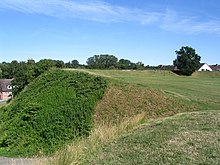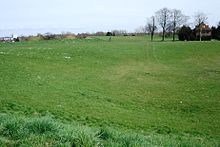Oldenburger Wall
The Oldenburger Wall is the remainder of a Slavic - later Holstein - fortification in the city of Oldenburg in Holstein in the Ostholstein district in Schleswig-Holstein , which is one of the most important archaeological monuments in Schleswig-Holstein. The complex was first researched archaeologically and documented by Karl Wilhelm Struve . The Oldenburger Wall is the origin of the city of Oldenburg in Holstein.
location
The Oldenburger Wall is located on the edge of a partly very damp lowland, which is criss-crossed by numerous watercourses. These are silted up and drained remnants of previously navigable waterways that were connected to the Baltic Sea as the foothills of the Oldenburger Graben . This location enabled extensive long-distance trade, which made the castle and the settlement around it - called Starigard ("Old Castle") one of the most important settlements in the Baltic region at that time .
description
These are the remains of an oval hill fort (in the last stage of expansion) (in west-east direction) approx. 220 meters long and approx. 100 meters wide, with the walls on the north, east and west sides extending up to the surrounding area tower over 18 meters. In the south, the area merges into the area of downtown Oldenburg without any noticeable difference in altitude. One building is located in the inner area of the ramparts. The ramparts only tower a few meters above the inner surface of the castle. The Oldenburger Wall, the finds from the excavations and the living environment of the Slavic inhabitants are documented in the nearby Oldenburg Wall Museum .
The hill fort was built in the Slavic style typical of the time, made of wooden box constructions filled with earth.
history
The Oldenburger Wall was expanded / used in several phases:
- After the immigration of Slavic ( Abodriten / Wagrier ) tribes into the area of eastern Holstein, a ring wall (the western part of the Oldenburg Wall) was built between 680 and 700 (AD), with a bailey in front of it to the east .
- After 750 the outer bailey was expanded like the previous main castle and this was added. At this time, the Slavic royal court was relocated to the former outer bailey.
- In 1148/1149 the castle was conquered and destroyed by Danes under Waldemar I.
- After 1200, a new castle was built by the Danish King Waldemar II - after the Battle of Stellau - on the remains of the Slavic fortifications.
- In 1227 the castle fell to the Schauenburger Adolf IV as a result of the battle of Bornhöved . This castle consisted of a northern and southern part separated by ditches, with a fortified strip remaining between the two. The three parts of the castle were connected by bridges.
- In 1261 the castle was besieged and destroyed (during the conflict between Count Gerhard I of Holstein-Itzehoe , Duke Erich I of Schleswig and King Erich V of Denmark ).
No new fortifications were built in the centuries that followed.
- From 1833, large parts of the wall were leveled.
- Between 1953 and 1958 and 1973 to 1986 the Oldenburger Wall was examined archaeologically.
- In 1986/1987 the Oldenburger Wall was partially reconstructed by placing earth on the walls.
literature
- Karl Wilhelm Struve: Preliminary examinations in the Slavic ramparts of Oldenburg in Holstein . In: Germania 33 . 1955.
- Karl Wilhelm Struve: The Slavic castle wall of Oldenburg in Holstein . In: Guide to Prehistoric and Protohistoric Monuments Volume 10 . 1968.
- Ernst-Günther Prühs: The "Oldenburger Wall" - the largest Slavic complex in East Holstein . In: Jahrbuch für Heimatkunde, Eutin . 1980, p. 56-64 .
- T. Kempke: Starigard / Oldenburg. Main castle of the Slavs in Vagria. The weapons of the 8th – 13th centuries Century. In: Offa books 73. Neumünster 1991.
- Series Starigard / Oldenburg . Offa books 52ff., Neumünster 1984ff.
- Michael Müller-Wille (ed.): Sta rigard / Oldenburg. A Slavic ruler's seat of the early Middle Ages in Ostholstein , Neumünster 1991.
- Erich Koglin: Chronicle reports about the Wendish time of the city of Oldenburg in Holstein . Oldenburg in Holstein 1995.
Web links
- Wall museum homepage
- Detailed information
- Data / history at www.eutin.de
- Slavic Period (PDF; 301 kB)
- Data / history at www.stranddorf.de
Individual evidence
- ^ Cf. Karl Wilhelm Struve: Slavic engineering works in Holstein. In: Schleswig-Holstein 10, 1961, pp. 276f. The same thing: the wooden box construction in the Slavic castle complex of Scharstorf, Plön district. In: Studies from Old Europe II, 1965, pp. 278–284
Coordinates: 54 ° 17 ′ 38.4 ″ N , 10 ° 53 ′ 6 ″ E



